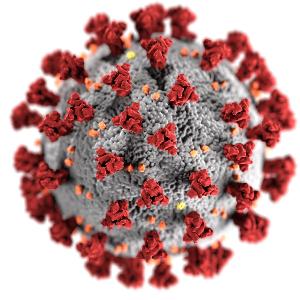How SARS coronaviruses reprogram host cells to their own benefit
20 Apr 2021
Researchers have found a specific mechanism that enables SARS viruses to replicate efficiently in infected cells.
20 Apr 2021
Researchers have found a specific mechanism that enables SARS viruses to replicate efficiently in infected cells.

© Alissa Eckert, MSMI, Dan Higgins, MAMS.
Coronavirus researchers led by Professor Rolf Hilgenfeld of the University of Lübeck and PD Dr. Albrecht von Brunn of Ludwig-Maximilians-Universität München have discovered how SARS viruses enhance the production of viral proteins in infected cells, so that many new copies of the virus can be generated. Notably, coronaviruses other than SARS-CoV and SARS-CoV-2 do not use this mechanism, which may therefore provide a possible explanation for the much higher pathogenicity of the SARS viruses. The findings appear in the EMBO Journal.
Coronaviruses that cause harmless colds in humans were discovered more than 50 years ago. When it emerged in 2002/2003, the SARS coronavirus was the first coronavirus found to cause severe pneumonia in infected people. Comparisons of the RNA genomes of innocuous coronaviruses with those of the SARS coronavirus permitted researchers to identify a region that only occurred in the latter, and was called the "SARS-unique domain" (SUD). Such genomic regions and their protein products might be linked to the extraordinary pathogenicity of SARS coronavirus and its cousin, the COVID-19 virus SARS-CoV-2.
The research groups led by Hilgenfeld and von Brunn showed that the SUD proteins of these two viruses interact with a human protein called Paip-1, which is involved in the first steps of protein synthesis. Together with Paip-1 and other proteins in human cells, SUD apparently binds to the ribosomes, the molecular machines that are responsible for protein synthesis in cells. This would lead to an enhancement of the production of all proteins, both those of the host cell and those of the virus. However, in cells infected with SARS-CoV or SARS-CoV-2, the messenger RNA molecules that code for host proteins are selectively destroyed by a viral protein named Nsp1. As a result of this complicated process, the infected cell predominantly produces viral proteins, so that many new copies of the virus can be created.
Albrecht von Brunn’s research group discovered the interaction between the proteins SUD and Paip-1 several years ago. "Being an experienced coronavirologist, I knew that one has to inspect the special regions of the SARS genome when trying to understand this virus,” he says.
The discovery made by the Munich researchers was of great interest to Hilgenfeld, whose research group had already elucidated the three-dimensional structure of the SUD protein some years previously. The two research groups teamed up. Dr. Jian Lei in Hilgenfeld's group, meanwhile a group leader at Sichuan University in Chengdu (China), succeeded in crystallizing the complex formed by SUD and Paip-1 and determining its three-dimensional structure by X-ray crystallography. And co-first author Dr. Yue "Lizzy" Ma-Lauer of von Brunn's group characterized the complex of the two proteins and its function using a variety of cell-biological and biophysical methods.
"Interaction studies of this kind between coronavirus proteins and proteins of the infected human cell will help us understand how the viruses change key functions of the cell to their own benefit," says Hilgenfeld.
EMBO Journal 2021